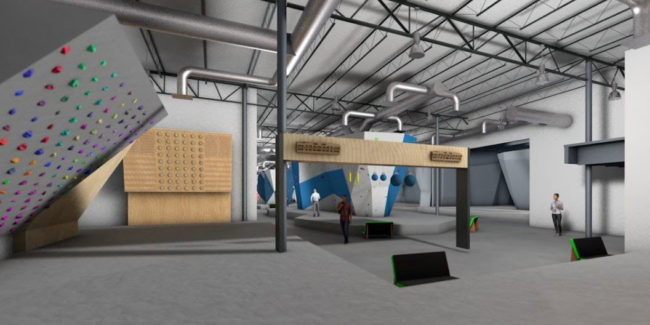
By Derek Larsen-Chaney and Jason Pill, Attorneys with Phelps Dunbar, LLP
Most large corporations began as small businesses, typically with one location, before expanding into multi-billion-dollar companies and nationally recognized chains. Before becoming the world’s largest restaurant chain, McDonald’s was simply a hamburger stand. In the fitness industry, LA Fitness is a +700-club chain that started off with one location. How does a business—specifically, a climbing gym—know when it would be an optimal time to expand?
Part 1 of CBJ’s series on corporate expansion looks broadly at the topic of expansion and dives into the two main options available to climbing gyms: internal or external expansion. Whether merging with another gym chain, opening additional locations, moving into a larger venue, or adding new products or services to your business, this three-part series will address basic principles of expansion that every gym owner should know before starting the process.
Know the Underlying Reasons for Expansion
Business growth—here defined as more demand and more revenue for a business—is often identified as a need. Business growth can be determined by various factors, but pursuing internal or external expansion of a business’s supply is often seen as a step in the right direction which validates an entrepreneur’s success. Yet, with expansion comes change, including different managerial, legal, and financial challenges.
Chris Warner, Founder of Earth Treks (now part of the El Cap family of gyms), once explained to CBJ that many owners “underestimate the luck” and fortunate circumstances which played a part in opening their first gym and gain a false sense of security when they try to expand too quickly. Sometimes, this mistake can be fatal. Expansion must be deliberate. Expanding even a small business can be a complex process. Throughout the process, it will be important to research targeted markets and understand corporate formation and how businesses grow.

Business growth can be planned or completely unexpected. Planned business growth is ordinarily achieved through the aspiration of the owner(s). The owner has a desire to see the business achieve its full potential and makes changes to reach more customers and increase revenue. Common methods of achieving planned growth include, but are not limited to, expanding the range of products or services offered—by selling more of the same and/or something completely different—or changing the underlying business concept.
As for unexpected business growth, it can be a benefit and a danger. Unexpected growth occurs when a business begins to experience an increase in demand for its products or services despite no additional internal efforts to do so. While the increase in demand may bring with it an increase in business revenue, if a business is not prepared to effectively manage this demand then it can result in careless decisions which lead to business failure. Expanding by scaling up and adding new locations is not always the right answer for gyms experiencing a surge of business.
Determining the best way to create or respond to business growth calls for strategic planning. The type of business strategy an owner ultimately chooses will depend on several factors, including the goals for the future, the size of the business, and the capital available. It is imperative that business owners understand the risks and rewards of each type of expansion and determine which (if any) is best for their desired growth levels in the long run.
Consider Internal Expansion First
Internal expansion concentrates on expanding the business by using the resources of the company. In addition to using the company’s own established finances, owners are often required to use their personal investments, money, and time. Businesses that participate in internal expansion typically keep the same brand name and services. Internal expansion provides the business owners with the flexibility of maintaining control over their products and services. A huge bonus in expanding internally is the high rate of financial return because the money is staying within the business itself, as opposed to being shared with external forces.
When a gym decides to expand internally, it can do so in various ways. For one, a gym can expand its venue. Venue expansion is necessary when the business has outgrown its original facility. This usually occurs when more customers are consistently interested in the services the gym is providing and, in order to meet these demands, a gym decides to relocate to a larger venue or add more space for climbing, fitness or other onto the existing one.

A gym also can open additional facilities. The gym must decide where to open the new location(s) and the types of services to provide (maybe a shiny new bouldering gym?). At first, it may be beneficial to open a location not too far from the original one because the business has already established a strong customer base in that area. Additionally, although the first location may be crowded because of growth in demand, some customers may not be willing or able to travel to a distant new location, even if doing so ensures fewer lines and fresh holds.
Internal expansion does not always call for opening a new facility or adding onto the old one. Sometimes, internal expansion can simply be the addition of new products or services within your current facility. A gym can expand by adding services such as yoga classes, personal training, nutrition advice, etc., and possibly experience comparable financial success from offering new services as from operating new locations. Some gyms begin as fitness centers with only machines and weight equipment and then add a climbing wall as an additional service.

All three options for internal expansion give the business owner(s) control over the process and allow funds to be reinvested into the business. However, remodeling a gym or building a new one takes time, and internal expansion is therefore often considered a slow and steady process.
Research the Risks and Rewards of External Expansion
Unlike internal expansion, external expansion depends on seeking outside assistance in order to expand. External expansion is known to be the riskier of the two forms of expansion because there is generally more money involved. However, external expansion is also considered the faster option and can happen almost overnight. External expansion uses corporate funds to purchase other companies or obtain additional resources and can include mergers, acquisitions, or partnerships. This can result in a gym coming together with other gyms, purchasing and acquiring other gyms, allowing itself to be acquired, or taking on new private partners. External expansion can help a business manufacture more products, enter into a new market, and gain the customer loyalty cultivated by another brand.
While external expansion is attractive because it often provides a quicker path for growth, the owner(s) almost always loses some form of control during the process. Typically, the infusion of external investment brings about new loan conditions, increased collateral securitization and, in some instances, a dilution of the owner’s stake in the company. External expansion which results in an increased ownership base can change the entire power dynamic of the company and impact the gym operations (e.g., the new investor receives voting rights and now must approve all major decisions or expenses above a certain threshold).
Given the complexities of external expansion and the kaleidoscope of options, the next article in this series will dive deeper into the various forms of external expansion, with insight into the pros and cons of each one.
Note: The content of this article is for informational purposes only and not for the purpose of providing legal advice. You should contact an attorney to obtain advice with respect to any particular issue or problem. The reading of or reliance on this article or the Climbing Business Journal’s web site does not create an attorney-client relationship between the author or the Climbing Business Journal and the user or reader.

Derek Larsen-Chaney is an attorney with Phelps Dunbar, LLP in Tampa, Florida. Derek practices in the areas of business and finance with a focus on real estate transactions, commercial lending, and corporate formation, including start-up business and climbing gyms. Derek has also provided guidance to startup companies in secured financing, private placement fundraising, and SEC reporting obligations.
 Jason Pill is a longtime climber and an attorney with Phelps Dunbar, LLP in Tampa, Florida. He practices in the area of Employment Law by advising clients, including climbing gyms, on workplace issues and representing clients in state and federal court when litigation becomes unavoidable. Additionally, Jason managed a climbing gym before embarking on a legal career, and he currently serves on USA Climbing’s Board of Directors and as the Chairperson of USA Climbing’s Ethics Committee.
Jason Pill is a longtime climber and an attorney with Phelps Dunbar, LLP in Tampa, Florida. He practices in the area of Employment Law by advising clients, including climbing gyms, on workplace issues and representing clients in state and federal court when litigation becomes unavoidable. Additionally, Jason managed a climbing gym before embarking on a legal career, and he currently serves on USA Climbing’s Board of Directors and as the Chairperson of USA Climbing’s Ethics Committee.








